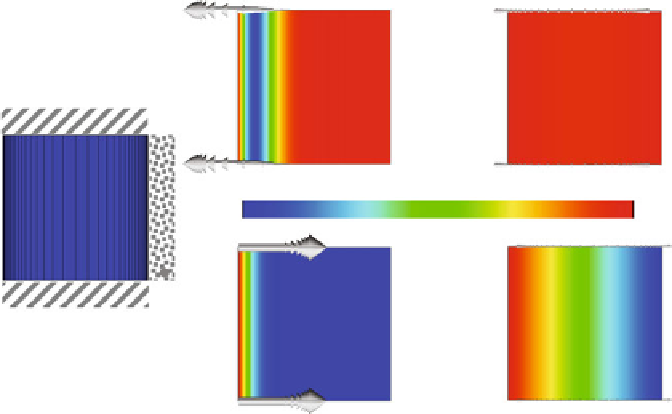Biomedical Engineering Reference
In-Depth Information
Fig. 17.2
Diffusion analysis for a biphasic-solute tissue. The finite element mesh is shown at
left
. For this analysis,
h
100 mM on the
left
(upstream face), and zero on the
right
(downstream) face. The remaining properties are the same
as in Fig.
17.1
. These conditions produce solute flux (diffusion) from
left
to
right
and solvent flux
(osmosis) from
right
to
left
. At steady-state, the fluid flux and solute flux are uniform and equal to
−
0
.
11
×
10
−
3
=
1 mm, the ambient pressure is zero, and
c
0
=
mm
/
s and 37
×
10
−
3
nmol
/
mm
2
·
s, respectively
osmosis, thus
c
Na
∗
u
c
Cl
∗
u
c
0
and
c
Na
∗
c
Cl
∗
d
c
0
. To produce electrophore-
sis and electroosmosis, let the electric potential in the upstream bath be
ψ
u
=
=
=
=
=
d
ψ
0
,
whereas the downstream bath is maintained at a zero potential,
ψ
d
=
0, thereby cre-
ating an electric potential gradient across the tissue thickness. Also let the pressure
equal ambient conditions in both baths,
p
u
=
0 and
p
d
=
0, to prevent permeation
and barophoresis. All of these conditions may be combined to produce the follow-
ing boundary conditions: On the upstream side,
c
Na
u
=
c
0
e
F
c
ψ
0
/Rθ
,
p
u
=−
2
Rθc
0
,
c
C
u
=
c
0
e
−
F
c
ψ
0
/Rθ
, and on the downstream side,
c
Na
d
c
C
d
=
˜
p
d
=−
˜
2
Rθc
0
,
˜
=
c
0
,
˜
c
0
(assuming
Φ
∗
=
1). For initial conditions, it may be assumed that the electric poten-
tial upstream is initially zero, thus
c
Na
c
Cl
p
˜
=−
2
Rθc
0
,
˜
=
c
0
, and
˜
=
c
0
throughout
the tissue initially.
When performing finite element analyses with charged tissues, it is important to
remember that a Donnan osmotic pressure arises between the tissue and its external
bathing environment, due to the charged solute matrix. Since electroneutrality must
be satisfied in the tissue and the bath, the tissue concentrations of anion and cation
differ by the amount of the fixed charge, whereas the bath concentrations of an-
ions and cations are the same; to satisfy both conditions simultaneously, while also
satisfying continuity of solvent and solute mechanoelectrochemical potential, an im-
balance in osmolarity and electric potential must exist between tissue and bath. This
imbalance is responsible for the Donnan osmotic pressure and Donnan potential
between the tissue and its surrounding environment. The Donnan pressure swells









































